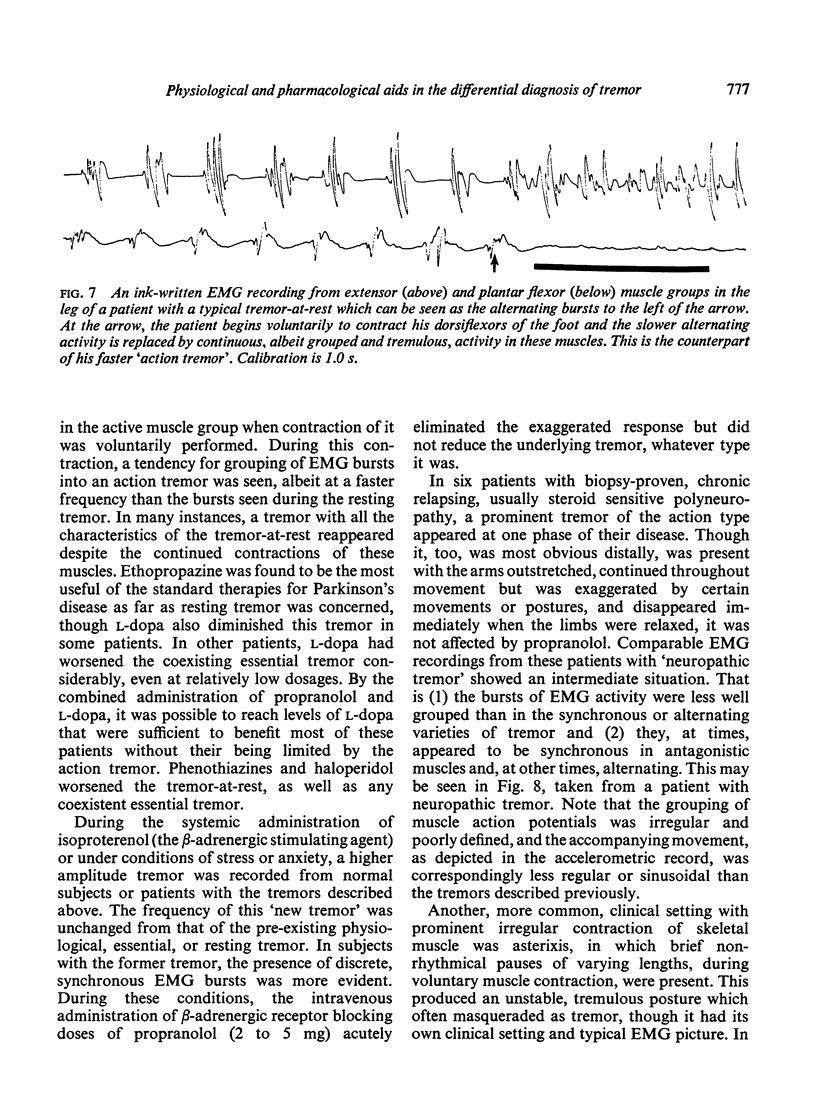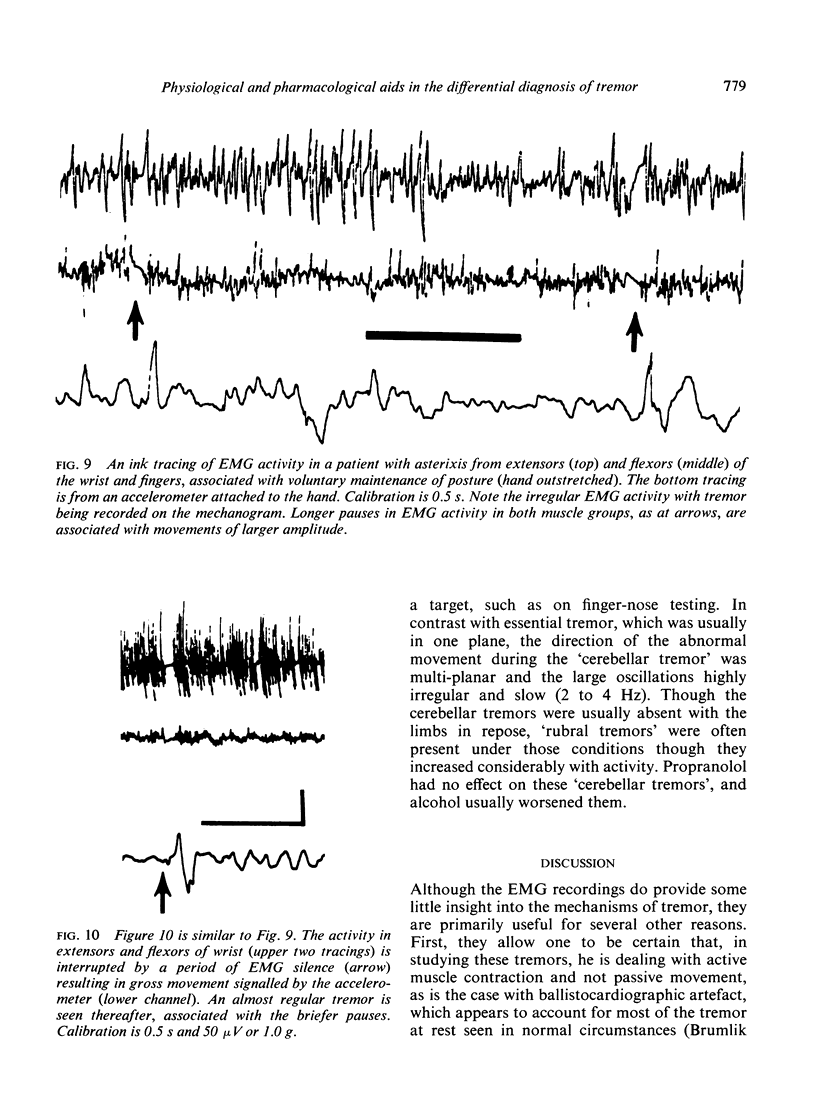Abstract
Physiological and pharmacological studies of more than 150 patients with movement disorders are reported. Particular attention is paid to the differentiation of various types of tremor on the basis of rate, rhythm, and pattern of EMG activity in antagonistic muscles. The typical 'tremor-at-rest' of Parkinson's disease--3-7 Hz activity which alternates between antagonistic muscles--is suppressed, at least briefly, during voluntary activity, at which time typical 8--12 Hz 'physiological tremor' may be seen. Essential tremor and its familial or senile variants also have a characteristic EMG pattern during voluntary activity--5-8 Hz bursts of activity which are synchronous in antagonistic muscles. This type of tremor may also be present in patients with Parkinson's disease and in certain kinships with a Charcot-Marie-Tooth polyneuropathy. Other tremors in association with polyneuropathy ('neuropathic tremor') have different physiological characteristics. Myoclonus is of essentially two types ('positive' with EMG bursts and 'negative' with brief pauses in ongoing activity, as with asterixis) and may, at times, mimic tremor. Certain specific tremors respond predictably to specific pharmacological therapy.
Full text
PDF











Selected References
These references are in PubMed. This may not be the complete list of references from this article.
- Bach J. F., Dardenne M. pH and rosette formation. Lancet. 1972 Mar 18;1(7751):633–633. doi: 10.1016/s0140-6736(72)90429-1. [DOI] [PubMed] [Google Scholar]
- Banker B. Q., Girvin J. P. The ultrastructural features of the mammalian muscle spindle. J Neuropathol Exp Neurol. 1971 Apr;30(2):155–195. doi: 10.1097/00005072-197104000-00001. [DOI] [PubMed] [Google Scholar]
- Dupont E., Hansen H. J., Dalby M. A. Treatment of benign essential tremor with propranolol. A controlled clinical trial. Acta Neurol Scand. 1973;49(1):75–84. doi: 10.1111/j.1600-0404.1973.tb01280.x. [DOI] [PubMed] [Google Scholar]
- Fahn S. Differential diagnosis of tremors. Med Clin North Am. 1972 Nov;56(6):1363–1375. doi: 10.1016/s0025-7125(16)32326-4. [DOI] [PubMed] [Google Scholar]
- Growdon J. H., Shahani B. T., Young R. R. The effect of alcohol on essential tremor. Neurology. 1975 Mar;25(3):259–262. doi: 10.1212/wnl.25.3.259. [DOI] [PubMed] [Google Scholar]
- Hardy J., Molina-Negro P., Bertrand C., Martinez N. S. Tremblement d'attitude: étude physiopathologique. Union Med Can. 1970 Mar;99(3):449–456. [PubMed] [Google Scholar]
- LANCE J. W., SCHWAB R. S., PETERSON E. A. Action tremor and the cogwheel phenomenon in Parkinson's disease. Brain. 1963 Mar;86:95–110. doi: 10.1093/brain/86.1.95. [DOI] [PubMed] [Google Scholar]
- LEAVITT S., TYLER H. R. STUDIES IN ASTERIXIS. I. Arch Neurol. 1964 Apr;10:360–368. doi: 10.1001/archneur.1964.00460160030002. [DOI] [PubMed] [Google Scholar]
- LIPPOLD O. C., REDFEARN J. W., VUCO J. The rhythmical activity of groups of motor units in the voluntary contraction of muscle. J Physiol. 1957 Aug 6;137(3):473–487. doi: 10.1113/jphysiol.1957.sp005828. [DOI] [PMC free article] [PubMed] [Google Scholar]
- Marsden C. D., Foley T. H., Owen D. A., McAllister R. G. Peripheral beta-adrenergic receptors concerned with tremor. Clin Sci. 1967 Aug;33(1):53–65. [PubMed] [Google Scholar]
- Morgan M. H., Hewer R. L., Cooper R. Effect of the beta adrenergic blocking agent propranolol on essential tremor. J Neurol Neurosurg Psychiatry. 1973 Aug;36(4):618–624. doi: 10.1136/jnnp.36.4.618. [DOI] [PMC free article] [PubMed] [Google Scholar]
- Murray T. J. Treatment of essential tremor with propranolol. Can Med Assoc J. 1972 Nov 18;107(10):984–986. [PMC free article] [PubMed] [Google Scholar]
- Schwab R. S., Young R. R. Non-resting tremor in Parkinson's disease. Trans Am Neurol Assoc. 1971;96:305–307. [PubMed] [Google Scholar]
- Sevitt I. The effect of adrenergic beta-receptor blocking drugs on tremor. Practitioner. 1971 Nov;207(241):677–678. [PubMed] [Google Scholar]
- Tolosa E. S., Loewenson R. B. Essential tremor: treatment with propranolol. Neurology. 1975 Nov;25(11):1041–1044. doi: 10.1212/wnl.25.11.1041. [DOI] [PubMed] [Google Scholar]
- Winkler G. F., Young R. R. Efficacy of chronic propranolol therapy in action tremors of the familial, senile or essential varieties. N Engl J Med. 1974 May 2;290(18):984–988. doi: 10.1056/NEJM197405022901802. [DOI] [PubMed] [Google Scholar]
- Winkler G. F., Young R. R. The control of essential tremor by propranolol. Trans Am Neurol Assoc. 1971;96:66–68. [PubMed] [Google Scholar]
- Young R. R., Growdon J. H., Shahani B. T. Beta-adrenergic mechanisms in action tremor. N Engl J Med. 1975 Nov 6;293(19):950–953. doi: 10.1056/NEJM197511062931902. [DOI] [PubMed] [Google Scholar]
- Yudell A., Dyck P. J., Lambert E. H. A kinship with the Roussy-Levy syndrome. Arch Neurol. 1965 Oct;13(4):432–440. doi: 10.1001/archneur.1965.00470040098016. [DOI] [PubMed] [Google Scholar]


